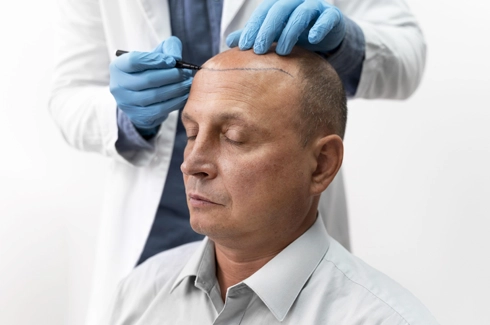

Hair transplantation has been applied with increasing number in recent years and successful results have been achieved. With the new techniques developed, the surgical procedure is performed faster and better cosmetic results are obtained. Considerations for successful hair surgery include:
Choosing the right patient for hair transplantation is important in terms of performing the surgical procedure without any problems and obtaining good results. Not every hair loss is suitable for hair transplantation. Androgenetic alopecia is the most common type of hair loss type in which hair transplantation is performed. Hair transplantation should not be performed in cases such as active cicatricial alopecia. For the correct diagnosis and the most appropriate treatment of hair loss, it is absolutely necessary to be evaluated by a dermatologist. In addition, hair transplantation should not be performed in cases such as unrealistic patient expectations.
Obtaining intact hair follicles from the donor region is very important for the success of the process. Damage to the hair follicles during harvesting, i.e. transection, negatively affects the viability of the hair follicles after hair transplantation. Various punches can be used to extraction of the hair follicles. Graft harvesting can be done without any damage to hair follicles with newly developed punches.
Appropriate placement of the harvested grafts is important for graft survival and also for natural appearance. One hair contaning follicular units and those containing more should be placed in the appropriate distribution. For example, if follicles containing 3 hair are placed on the hairline, it will cause an unnatural appearance. Furthermore damage to the follicles during transplantation will cause hair loss.
Hair transplantation is a long-lasting surgical procedure and is performed under local anesthesia. During the procedure, appropriate anesthesia is essential so that the patient does not feel pain and the surgeon can work comfortably.
To avoid overdose and possible intoxication, one should always anesthetize only those areas that will be treated immediately. This assumes that the entire treatment is performed and monitored by the physician.
Diagnosis and treatment of hair diseases should be done by dermatologists. Hair transplantation is a surgical treatment procedure and requires expertise and experience.
Dr. Civas is one of the most respected and qualified hair transplant surgeons in the world. Dr. Civas is Board Certified in Dermatology and a member of Fellows of the International Society of Hair Restoration Surgery (FISHRS). He is also certified by the American Board of Hair Restoration Surgery. He is the first doctor in Turkey to have his FISHRS title by fulfilling the necessary requirements in the field of hair surgery. ISHRS (FISHRS) is an academic honor of excellence and expertise with regards to hair loss and transplantation.
Civas Hair Transplant that is the best hair transplant clinic in Turkey is first choice if you want good quality work and a personalised experience. In order to get premium care and best natural hair transplant results, contact with Civas Hair Transplant and get consultation with doctor.
The basic logic of hair transplant; hair is taken from an aesthetically suitable area (donor) that will most likely not to be affected by hair loss and is transplanted to the desired area. The major limitations of hair transplantation are the patient’s expectations, the sufficiency of the donor hair, the size of the bald area, the cause of hair loss, experience of the surgical team and the possible medical risks.
The basic logic of hair transplant; hair is taken from an aesthetically suitable area (donor) that will most likely not to be affected by hair loss and is transplanted to the desired area. The major limitations of hair transplantation are the patient’s expectations, the sufficiency of the donor hair, the size of the bald area, the cause of hair loss, experience of the surgical team and the possible medical risks.
In female patients, the main factors that limit hair transplant are; the cause of hair loss, the prognosis and donor hair sufficiency. Female patients have different expectations from male patients. However young patients pose another more important limitation; they have very high expectations yet their hair loss is not stable. This is a group that should be carefully evaluated in terms age and expectations.
Hair transplant in cicatricial alopecia cases is mostly limited by indications. Currently there are no precise conclusive judgments with regards to primary cicatricial alopecia cases. Theoretically, you can detect if the disease is chronic or not by monitoring the relapses. Unfortunately, there is no alternative treatment method for the patients to regain back the lost hair. Secondary cicatricial alopecia is caused by factors like burns, accidents, trauma and surgery. In such cases, hair transplant can produce satisfactory results if there is adequate blood supply in the scar tissue and sufficient donor hair.
Other possible limitations which should be carefully evaluated before surgery; allergic reactions to medication used during the surgery and other side effects. The hair transplant candidate should also be evaluated in terms of local anesthesia as well as bleeding disorders. Increasing the capacity of the donor by hair cloning will eliminate the biggest limitation in hair transplantation. Additionally, another factor that can help eliminate this limitation is use of alternative donor hair from the beard, chest and legs.
I visited Dr Civas’ Hair Transplangt Center twice; first time in 2021 and recently in February 2023. I was referred to the clinic by a friend who had a great experience a{...}
12.08.2023I have just had a hair transplant and am amazed by the professionalism and super service, from the first contact to the operation and following checkups. Everyone has bee{...}
07.09.2023The trip to Ankara and the clinic was great. The clinic staff was friendly and took good care of me throughout the trip. A little over a year has passed since the operati{...}
07.09.2023